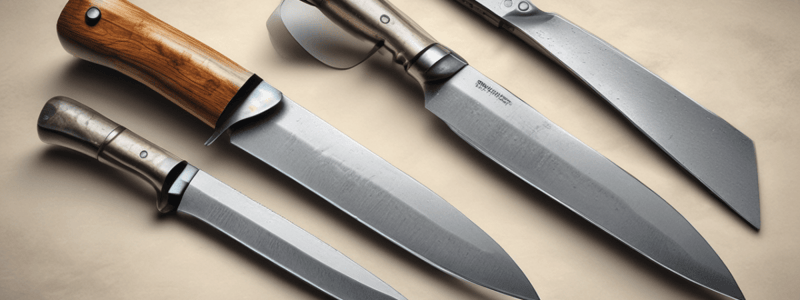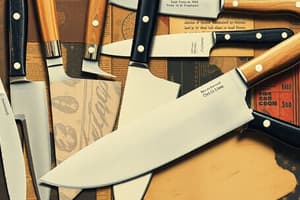Podcast
Questions and Answers
What is the difference between a forged knife and a stamped knife?
What is the difference between a forged knife and a stamped knife?
Forged knives are made from a single piece of metal, while stamped knives are made from a single sheet of steel cut into shape.
Describe the parts of a forged knife.
Describe the parts of a forged knife.
A forged knife consists of a blade and a tang made from one continuous piece of steel.
What is the purpose of a chef's knife in the kitchen?
What is the purpose of a chef's knife in the kitchen?
A chef's knife is used for chopping and dicing vegetables, as well as handling heavy-duty chopping work.
Explain why a chef's knife is considered a versatile tool.
Explain why a chef's knife is considered a versatile tool.
How does the design of a chef's knife contribute to its effectiveness in the kitchen?
How does the design of a chef's knife contribute to its effectiveness in the kitchen?
What is the main purpose of a paring knife in the kitchen?
What is the main purpose of a paring knife in the kitchen?
Describe the design of a paring knife that makes it suitable for delicate work.
Describe the design of a paring knife that makes it suitable for delicate work.
What type of foods are serrated knives specifically designed to cut through?
What type of foods are serrated knives specifically designed to cut through?
Explain why a serrated knife is preferred for slicing bread over other types of knives.
Explain why a serrated knife is preferred for slicing bread over other types of knives.
What distinguishes a bread knife from other knives based on its design and intended use?
What distinguishes a bread knife from other knives based on its design and intended use?
Flashcards
Forged Knives
Forged Knives
Made from single piece of heated steel, hammered for strength.
Stamped Knives
Stamped Knives
Cut from a sheet of steel, lighter, and cost-effective.
Chef's Knife Purpose
Chef's Knife Purpose
General food prep, chopping, slicing, and dicing.
Paring Knife Purpose
Paring Knife Purpose
Signup and view all the flashcards
Serrated Knife Usage
Serrated Knife Usage
Signup and view all the flashcards
Knife Edge
Knife Edge
Signup and view all the flashcards
Knife Heel
Knife Heel
Signup and view all the flashcards
Knife Tip
Knife Tip
Signup and view all the flashcards
Knife Tang
Knife Tang
Signup and view all the flashcards
Study Notes
Knife Differences
- Forged knives are made from a single piece of heated steel, shaped through hammering, resulting in a denser and stronger structure.
- Stamped knives are cut from a sheet of steel, making them lighter and often more cost-effective but less durable than forged counterparts.
Parts of a Forged Knife
- Blade: Heavily constructed for enhanced strength and durability.
- Edge: The sharpened part of the blade for cutting.
- Heel: The rear part of the blade used for cutting tasks requiring force.
- Tip: The front of the blade used for precision tasks.
- Handle: Provides grip and control, often made from wood, plastic, or composite materials.
- Tang: The portion of the blade that extends into the handle, offering balance and support.
Chef's Knife Purpose
- A chef's knife is designed for general food preparation, including chopping, slicing, and dicing a variety of ingredients.
Versatility of a Chef's Knife
- It can handle multiple tasks such as cutting vegetables, meats, and herbs, making it an essential tool in any kitchen.
- The blade's shape allows for a rocking motion, which enhances its cutting technique.
Design Contributions to Effectiveness
- The wide blade provides ample surface area for chopping and transferring food.
- The tapered tip makes it ideal for precision tasks, while the curved edge allows for smooth rocking motions during cutting.
Purpose of a Paring Knife
- A paring knife is designed for intricate tasks that require precision, such as peeling, trimming, and detailed work on small fruits and vegetables.
Design of a Paring Knife
- Features a short, narrow blade that allows for maneuverability and control.
- The lightweight design makes it easy to handle for detailed cutting.
Serrated Knife Usage
- Serrated knives are specifically designed to cut through foods with tough exteriors and soft interiors, such as bread, tomatoes, and citrus fruits.
Preference for Bread Slicing
- A serrated knife's teeth grip and tear through crusty exteriors without squashing the soft insides, making it ideal for slicing bread cleanly.
Bread Knife Design Features
- Longer blade with deep serrations to facilitate cutting through thick crusts.
- A straight handle for better leverage and control when slicing to achieve uniform cuts.
Studying That Suits You
Use AI to generate personalized quizzes and flashcards to suit your learning preferences.




